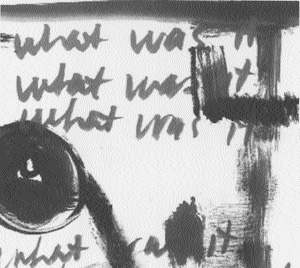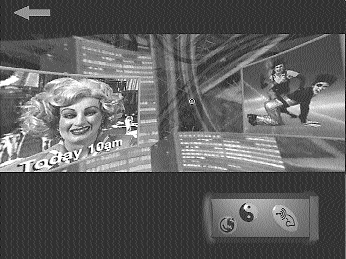techné cultures
Mike Leggett scans cyber expositions east and west
PICA’s contribution to the opening of the Festival of Perth resolved that three days of art(iculations) was the way to go, and electronic media, including the techné exhibition, had pole position in the race for early attention. In Sydney’s south-west, the Casula Powerhouse hosted Cyber Cultures an event which may well become an annual national survey of new digital art.
The variations on the term ‘work in progress’ is on view—processes of experiment, lines of inquiry, informal research into multimedia. And the tools themselves are subject to continuous redefinition as a set of technical and therefore aesthetic options. These parallel processes of evolution become content, the very notion of ‘completion’ is in question, thereby creating problems for visitors seeking ‘product’.
techné
This exhibition of new media art was co-curated by Michelle Glaser, and Rick Mason from IMAGO Multimedia Centre. techné combined the full gamut of current activity into four spaces at PICA, adjacent to the touring exhibition Burning the Interface: International Artists’ CD-ROM, thereby providing a perspective across both shows and the astonishingly short period of five years. Two installations, a video lounge, and some 30 multimedia pieces—most produced since mid-1995 by international and mainly Australian artists—were available on six computers for interaction via mouse and keyboard. Of these, about one third were works from recent Australian graduates which, whilst demonstrating competency, did not always develop ideas or the potential of the medium beyond a well established mean. Graduating students are demonstrating the conflicts inherent in exploring the less-than-new media by not only pursuing the necessary research and development objectives, but also by trying to attract the attention of potential investors.

Norie Neumark, A Shock in the Ear
Other works displayed the broader and less literal investigations that need to occur at an advanced level in order to expand the use of multimedia. Shock in the Ear, devised by a small team led by Norie Neumark, places sound into the frame for careful scrutiny as the under-exploited medium amongst the multimedia. Fragments of sounds and sentences are triggered by mouse rollovers, movement across painted images and graphics—the cursor might contain a hand-written word: “how”, “where”, “what”, the word repeated and developed in a cadenza of narrative and related and unrelated sound effects and music. Neumark’s long association with sound works accounts for a maturity in the architecture of her poetry and the way it becomes performance, open to variation and nuance according to the response of the interacting subject. Similarly, the visuals perform in various juxtaposition, though not as lyrically. Instead of the concrete, the visual track relies on the expressionist, using typography and the obfuscation of reprographics. Navigation is complex, causing loops to repeat and leave you wondering whether you had influenced a flow or simply observed a pre-determined change.
Martine Corompt’s The Cute Machine (also exhibited at Cyber Cultures), takes the spherical render into the kind of artificial life areas invented and perpetuated by Disney aesthetics, re-defined and re-distributed by Japanese comics’ obsession with the Euro ‘round-eye’ infant-being, and identified by zoologists as neoteny. (Is that teeny as in tiny?) Well, infantile traits it seems under the Neotenic influence can remain with otherwise fully matured adults and become an aesthetic which Corompt demonstrates as a mutational form. The lurid pinks and sickly greens on the screen and the vinyl ‘skin’ of the installation are suitably unsettling, reminding us of the proximity of bovine to beef, cherubs to nappies, round eyes to famine appeals…cute to lie.
Linear electronic forms in the video lounge did not all have those smoothly rendered surfaces. Sam Landels’ Hydra revisited systems of representation based on persistence of vision, ingeniously adapting video technology to the formal task in hand. Strobing and fragmentation foregrounded the image as object and, with a dynamic relation to the frame, process.
techné demonstrated that artists have reached a critical mass in relation to interactive multimedia, particularly by visiting the web sites that had been bookmarked. The informative catalogue reveals that many of the new and younger artists have been trained straight into multimedia, without bringing the baggage of the Jurassic—this has clearly weakened some whilst liberating others, depending on their points of reference and I suppose, your point of view.
Cyber Cultures

VNS Matrix, BAD CODE
Cyber Cultures was curated by Kathy Cleland and David Cranswick through Street Level, which supports and advocates contemporary art initiatives for artists and audiences in Western Sydney.
The expansive physical framework of the Powerhouse provided draped nooks and crannies for video projector-based interactive installations, and a screenings area. Two seminar days and evenings of performance complemented this rich survey of new media work.
Thematically, the ten interactive installations were concerned “…with issues of human identity and its boundaries…”, in the evolutionary sense. They were also linked financially: nine of the works represented the outcomes of the Australian Film Commission’s investment in artists’ projects; the Australia Council assisted with two.
Troy Innocent’s Untitled, as the title suggests, is in development but advances loudly into the AL (artificial life) area. Innocent moves away from an obsession with shiny and globular entities towards the generation of (loud and shiny) sounds created by the visitor drop-and-dragging globular creatures into a circle projected onto a camera obscura-like table-top. It has something of the feel of an ornamental pond where the fish breed simply to provide the unsettling sounds of industrial mayhem!
The User Unfriendly Interface from Josephine Starrs and Leon Cmielewski assaults the sensibilities of gentle nerds with a lot of impertinence, puns and other slippery slopes designed to remind us in faux troglodyte style that the personal computer is a dubious thing. The customised casing looks ready to rip your eyes out.
Merlin Integrated Media’s interactive CD-ROM, Metabody, documents one of the most interesting collaborations to occur in Australia last year between Stelarc, Merlin and Mic Gruchy, which included an ‘electrifying’ live world wide internet performance at Artspace last April. This interactive is encyclopedic, ranging from Stelarc’s hook suspensions to the direct wiring of the audience. It is the snapshot of a career, but has built in the ability—via an internet connection—to not only update but also extend the means by which the audience may participate.
The long anticipated Bad Code from the VNS Matrix team made a sneak preview, treading “a fine line between artwork and commercial prototype, aiming to inject alternative narratives and characters into a ‘shoot-em-up’ dominated games market”. The All New Gen mob together with the DNA Sluts up against Big Daddy Mainframe (BDM) is the basic scenario that has been rehearsed some time now, and one has to ask in these days of internets and intranets, how has BDM survived as the villain? Whilst ‘the look’ is intriguing, the feel for the game is obscure and it currently remains true to its title.
Invert is somewhat enigmatic. Lloyd Sharp’s “organic artwork” is about organs…and other processes, and parts, and orifices…about various of our physical functions, vectored through the sensibilities of the artist’s own experience of challenged health. It is an interactive partially using the game metaphor but mainly approached using Sharp’s idea of the metaphor of “personality”—which could be another way of saying unpredictable. Hence the enigma. Whilst the piece is life affirmative and has amusing cursor devices that ambush one another on screen, its personality swings between the pedagogic statement and a visceral space of images.
This is quite unlike the clear spaces that are created in another internal journey, Isabelle Delmotte’s Epileptograph. Large high definition images and shattering sound provide internalised glimpses of the experience of epileptic seizures, from which Delmotte suffers. Sequences of these images are shown on small video screens. (The process of making this work has also enabled the artist to reclaim to consciousness parts of the experience which are otherwise entirely erased from her memory.) Finally, a word description of the five stages of a siezure from the artist’s point-of-view. As a totality, we comprehend, through the cognitive process, and at a safe distance.
Both exhibitions had major involvement from the Industry and Cultural Development Branch of the AFC, and a haggle of others. Audiences can now look forward to a period where, in the public spaces, work is prudently selected, where the time required for participation or even interaction with multimedia work is in relation to the kind of concentration that most people can sustain during a single visit. On-line participation, the promised connections permitting, will become like videos and television—subject to the vicissitudes of the audience in response to the matrixes of options. Whilst techné, gave us another glimpse of this future, Cyber Cultures not only celebrated the physically interactive exhibition spaces of Casula but enabled the socialisation of many of the exhibits, a step away from what one arts commentator has helplessly observed as the “diminished aesthetic experience of a video monitor…”
techné, IMAGO, at PICA, Festival of Perth, February 13-March 9
Cyber Cultures, presented by Street Level at the Casula Powerhouse, Casula, Sydney, March 9–April 6, 1997
RealTime issue #18 April-May 1997 pg. 21






